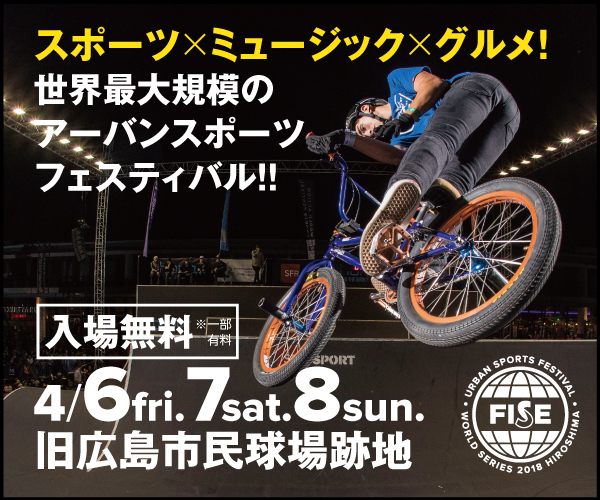Bringing a new wind to the culture of Nishijin textile! “Bank of Craft” introduces a new charm of Nishijin textile fused with “Street culture”.
J&J Business Development Corp. established the project called “Bank of Craft”, which promotes the use of traditional crafts in the regional ecosystem by fusing creative works, art, and digital technology to develop tourism resources, solve regional issues, and create a new primary resource of revenue in craft production areas, rather than just maintaining the value of the craft as a product.
As the first edition of this project, Kyoto Nishijin Textile, FINEPLAY, 430(Four-Thirty),and CURRENT have joined this collaboration to create premium skateboards and kendamas, which are now on sale.
In this article, we interviewed Kentaro Yasuda, the CEO of Yasuda Corporation., Soichiro Imagawa, the president of Kiyata Imagawa Orimono Co., and Sakio Ohba, the president of Kyoto Nishijin Oba. They are in charge of the design production of this project and also are the members of N180 (Nishijin One Eighty), a group that promotes new culture in the Nishijin.
We are honored to have central figures of this project that crosses over the two different cultures between Japan’s world-class traditional culture and street culture which originated from the West. We asked them about the historical background of the Nishijin Textile, the challenges they face, and their thoughts behind the unique collaboration of “Urban Sports x Nishijin Textile”.
Kentaro Yasuda (Hereinafter: Yasuda)
Soichiro Imagawa (Hereinafter: Imagawa)
Sakio Ohba (Hereinafter: Ohba)
Historical background of how “diversity” became a characteristic of Nishijin Textile
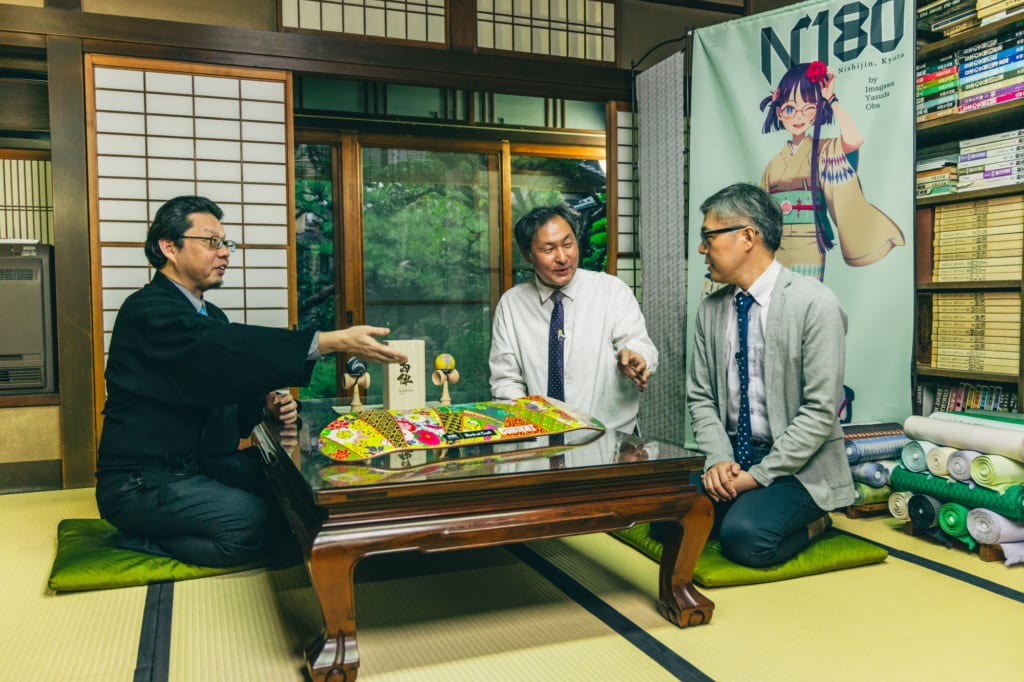
The history of textiles in Kyoto began about 1,200 years ago when the first people arrived in Japan. So this traditional craft has a very long history, including the period when Kyoto was the capital of Japan.
Since Nishijin textile craftsmen in Kyoto have dealt with the detailed needs of the wealthy class such as the so-called noble family and royalty, this industry has built a system to tailor to detailed requests and needs from customers.
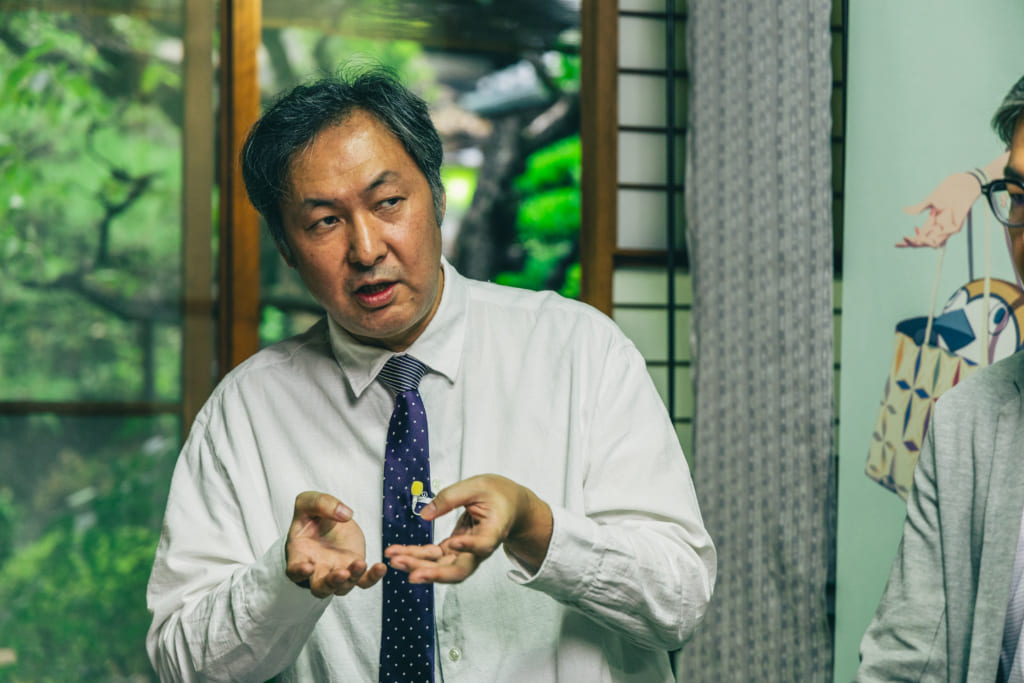
This system is enabled by “division of work”, which means that the work is allocated to specialists in each process. This “division of work” is quite characteristic of Nishijin textiles craftsmanship and its own “diversity”, Soichiro Imagawa said.
Imagawa: Back in the days when all Japanese wore kimonos, kimonos were not treated as special clothing but had various uses ranging from everyday wear to ceremonial wear.Nishijin textile manufacturers made obis and kimonos to meet those needs, so it was not a matter of them “preserving some tradition” but rather creating more products that fit the background of the times. In this process, the “division of work” was developed to make it more efficient as an industry, and specialists in each process came out and expanded the “diversity” of products to be made. This is a historical backdrop that the Nishijin Textile industry has travelled.
Challenges facing the “Modern” Nishijin Textile

Over time, however, the Nishijin textile industry has faced many challenges. One of the most serious problems is a lack of successors.
In the division of work that has supported the diversity of the Nishijin textile, even if only one specialist in each process ceased to exist, the entire process would come to a standstill.
So Nishijin textile manufacturers are trying various measures, such as training successors from younger generations among themselves. However, the current problem is that they are unable to keep up with the speed at which the scale of their business is shrinking.
To solve these problems, an organization called “N180” was launched to promote a new culture of Nishijin textile.

Mr. Sakio Ohba, the president of Kyoto Nishijin Ohba, the only textile manufacturer in Japan that uses “Tsuzura-yarn,” said the following.
Ohba: In the face of such problems, we started an organization called “N180”. The reason why we chose the word “180” in the name of this group is that it means to turn things upside down so we want to change this current situation under the name. We also have a YouTube channel and are working on letting fans know about the current situation that the kimono production area is facing and the appeal of obis and kimonos from the perspective of their manufacturers.
The feelings behind “Nishijin Textile x Urban Sports”
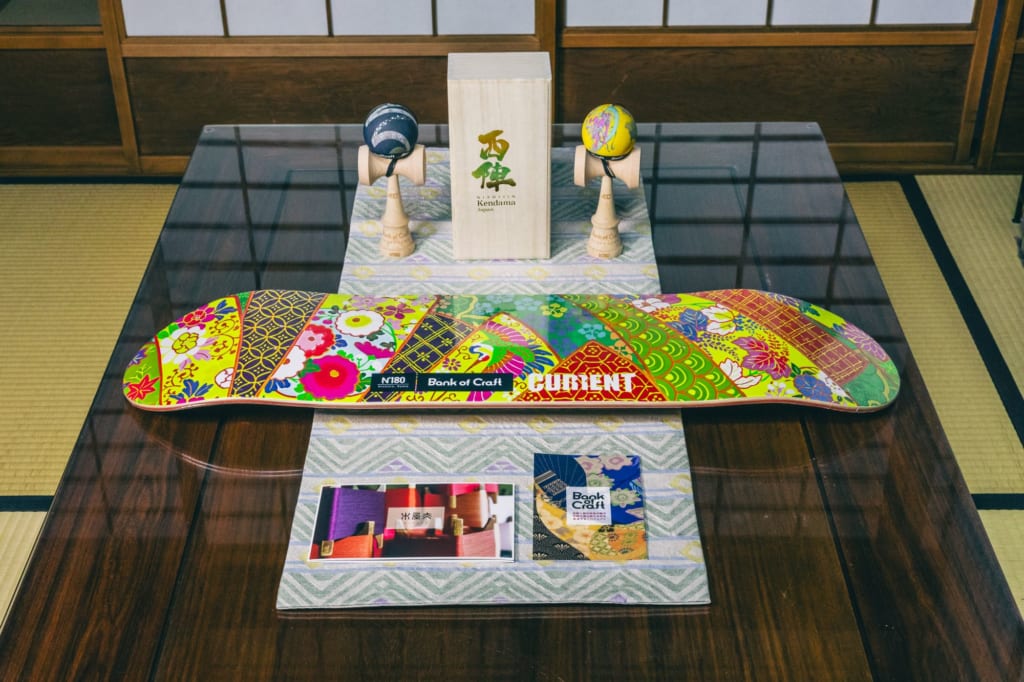
The activities of N180 were the catalyst for this “Bank of Craft” project. Mr. Imagawa and the members of N180 thought it was about time to create a new product so made a decision like “We have to get on board!”. And he added,
Imagawa: We simply like interesting and new things (laughs). And we joined this project because it was completely linked to what we have wanted so we had no choice but to get on board.
While such kimonos have a strong top-down cultural element, on the other hand, I think street culture is truly a bottom-up culture so we were very excited to see how Nishijin textiles could be introduced and accepted in a completely different world.
New charm of Nishijin textile is now introduced by new approaches
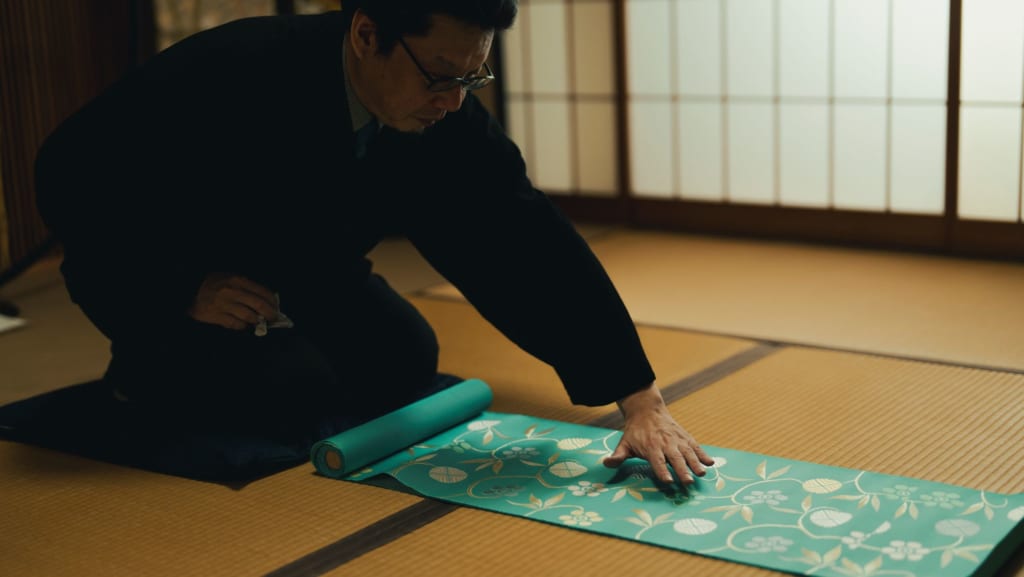
In everyday production, it is difficult to balance the two elements of “art” and “product” when thinking about its design within the canvas of obi or kimono.
However, “It was stimulating for us to have an offer with this kind of design because it allowed me to challenge myself from a different angle,” said Mr. Kentaro Yasuda, the president of Yasuda Co.
And he also added with his impression of this unique collaboration as follows.
Yasuda: Kendama is originally a Japanese game but recently has become a worldwide sport, and I think it is very interesting that kendama with Nishijin patterns is spreading to the world. On the contrary, skateboarding is a culture that originated in the U.S., and I think it is very cool to see the precise patterns of Nishijin textile on the back of skateboard decks when skaters perform various tricks.
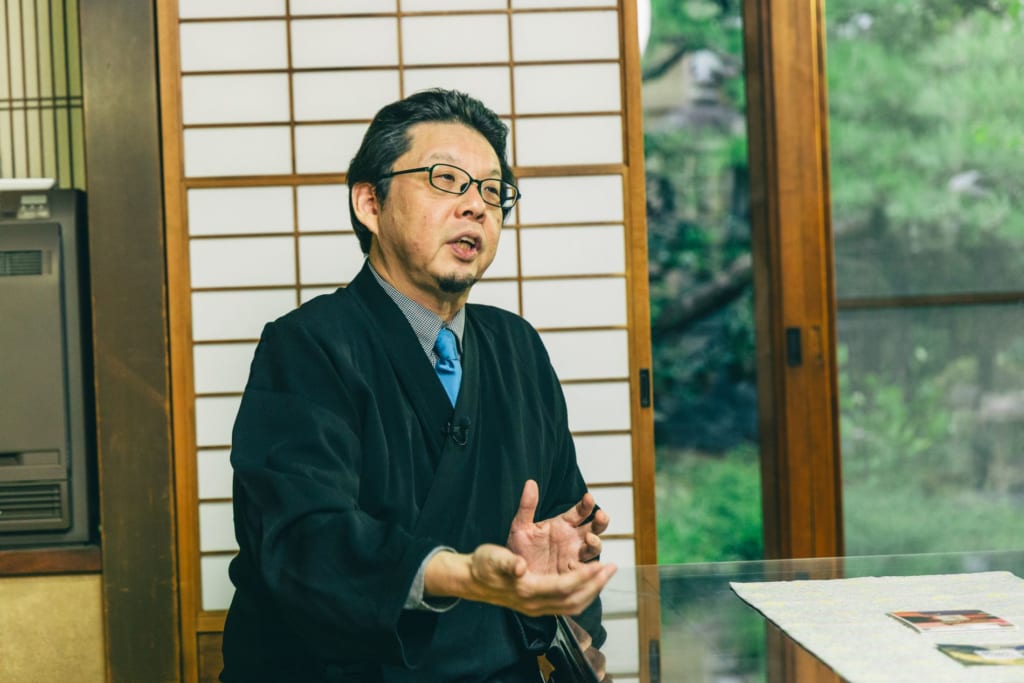
Finally, Mr. Ohba shared his impressions of the products and his vision for the future.
Ohba: While we design kimonos and obis, it was a fresh surprise to see the different points of view that the designers in other genres focus on when we turn our design into products. Nishijin textiles have a long history and have produced many designs in the past, but I have a hope that other designers and different points of view will show us new charms so I would like to see more new collaborations in the future!
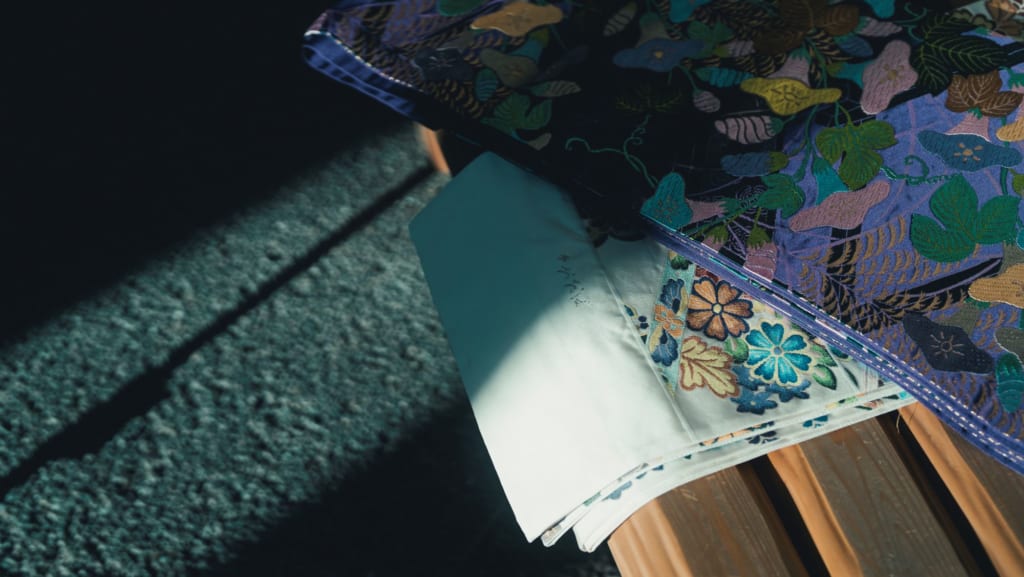
Since the Nishijin textile production area has various historical backgrounds, this kind of new contemporary initiative will probably bring a new wind to the traditional craft production areas throughout Japan.
We will continue to stay tuned with the development of “Bank of Craft” project and new expressions that come with traditional crafts in the future.
These products can be purchased online from the FINEPLAY EC site so everyone including skaters, kendama players, and collectors in Japan can enjoy this unique collaboration of traditional craft design “Kyoto’s Nishijin-ori” and urban sports. Please check them out.
Product Information

Traditional Craft Designed Skateboard & Kendama Full Package
*Only 10 sets available
This full package includes the collaboration skateboard with “Nishijin textile (Kyoto)” and the skateboarding media “CURRENT”, and the collaboration kendama with “Nishijin textile (Kyoto)” and “430 (Four-Thirty)” known as the leader in Japanese kendama culture.
Price: 35,000 yen (38,500 yen – tax included)
<Traditional craft designed skateboard and Kendama Full Package>
-Traditional craft designed kendama “Wind God and Thunder God”
-Traditional craft designed kendama “Noe Tanzaku”
-Traditional craft designed skateboard “Keijuhakuohbun”
<Special Gift for those who purchase the full package>
An original NFT (Until March 31, 2024) , a Bank of Craft limited edition not-for-sale T-shirt and an original strap will be given as a special gift to those who purchase the full package!
*The Bank of Craft limited edition T-shirt is only available in size L.
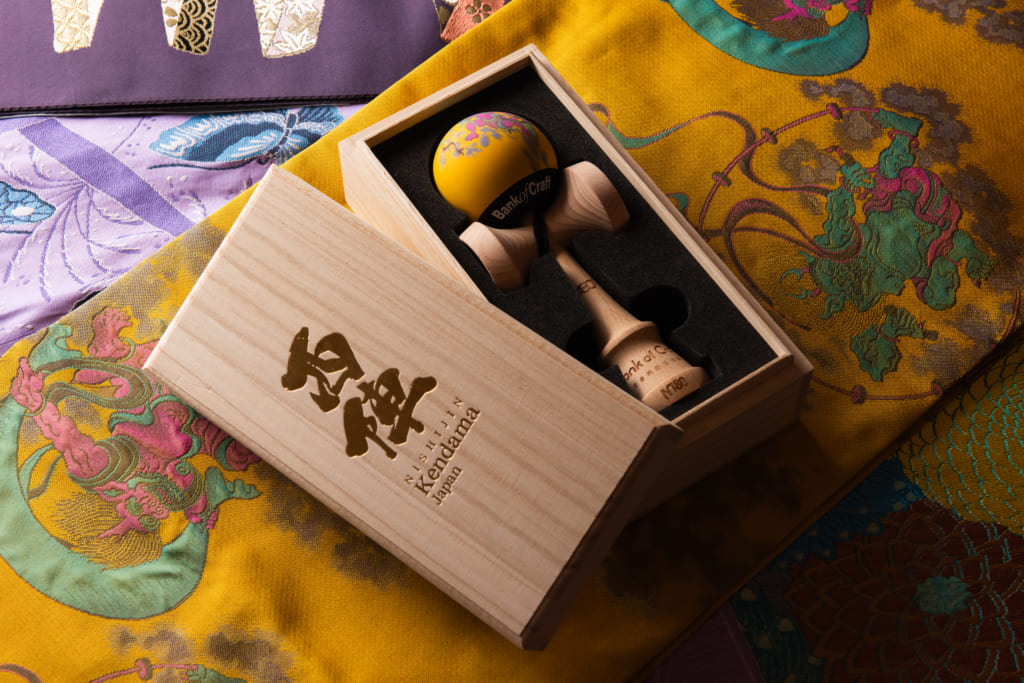
【Bank of Craft×Nishijin textile×430】
Traditional craft designed kendama “Wind God and Thunder God”
This kendama is made in collaboration with Nishijin textile (Kyoto), a traditional Japanese craft design, and “430 (Four-Thirty)”, the leader of Japanese kendama culture. The Sarado is enlarged compared to the regular one so that both beginners and experts can handle it, and the size of the ball hole is also adjusted to larger size specifications. The soft and splendid beech material used for the product allows the users to enjoy how the material ages by the texture and visual appearance. This product is also packaged in a special paulownia box so you can enjoy a luxurious look as an interior accessory by keeping it in the box.
Price: 12,700 yen (13,970 yen – tax included)
※This price is set per item.
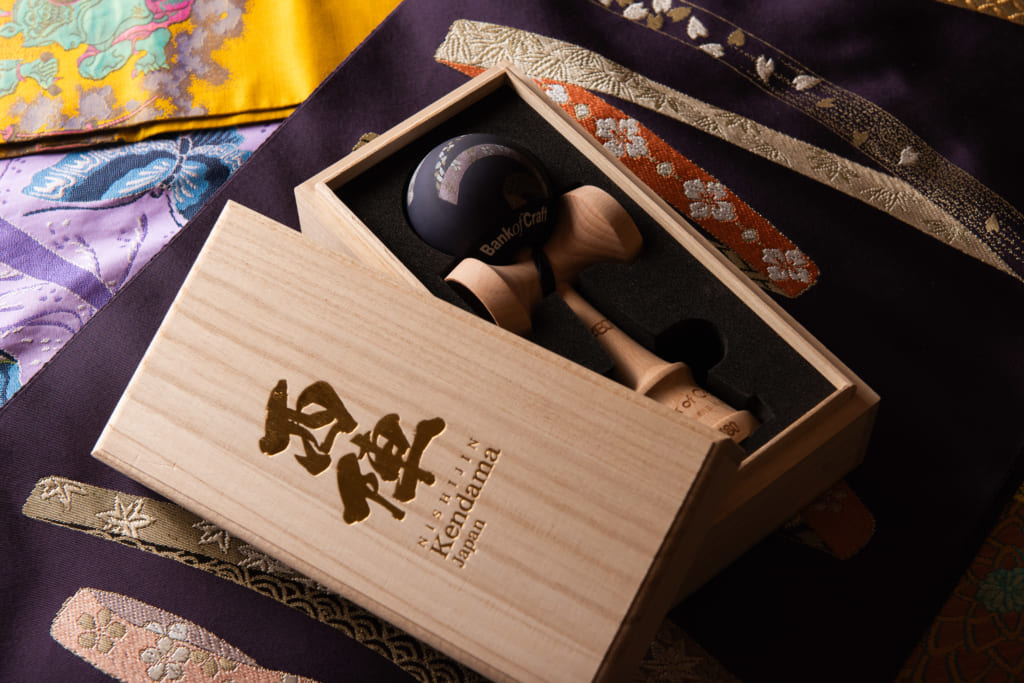
【Bank of Craft×Nishijin textile×430】
Traditional craft designed kendama “Noe Tanzaku”
This kendama is made in collaboration with Nishijin textile (Kyoto), a traditional Japanese craft design, and “430 (Four-Thirty)”, the leader of Japanese kendama culture. The Sarado is enlarged compared to the regular one so that both beginners and experts can handle it, and the size of the ball hole is also adjusted to larger size specifications. The soft and splendid beech material used for the product allows the users to enjoy how the material ages by the texture and visual appearance. This product is also packaged in a special paulownia box so you can enjoy a luxurious look as an interior accessory by keeping it in the box.
Price: 12,700 yen (13,970 yen – tax included)
※This price is set per item.
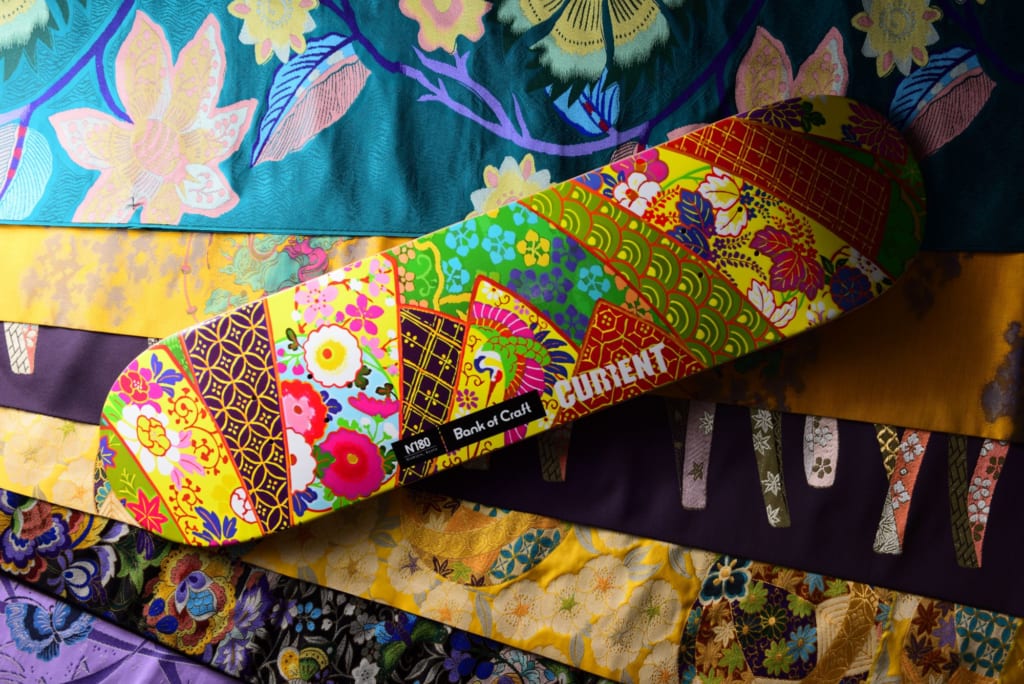
【Bank of Craft×Nishijin textile×CURRENT】
Traditional craft designed skateboard “Keijuhakuohbun”
This skateboard is created by Bank of Craft, a project that aims to reconstruct the value of traditional crafts and arts, and to inherit and develop traditional crafts by taking advantage of its techniques and shaping them to suit modern life through some development and crossover under their mission of building a new business model of traditional crafts and arts,This product is made in collaboration with Nishijin textile (Kyoto), a traditional Japanese craft design and skateboarding media “CURRENT”.
Price:15,000 yen (16,500 yen – tax included)
SPECIAL EDITION

FINEPLAYはアクションスポーツ・ストリートカルチャーに特化した総合ニュースメディアです。2013年9月より運営を開始し、世界中のサーフィン、ダンス、ウェイクボード、スケートボード、スノーボード、クライミング、パルクール、フリースタイルなどストリート・アクションスポーツを中心としたアスリート・プロダクト・イベント・カルチャー情報を提供しています。
アクションスポーツ・ストリートカルチャーの映像コンテンツやニュースを通して、ストリート・アクションスポーツの魅力を沢山の人へ伝えていきます。
●今日 ○イベント開催日
-
culture約7万2000人とダンスと音楽で一緒に10周年を祝った3日間。弘前から世界へ。夢を与え続けるフェス「SHIROFES.2025」2025.07.05今年で10周年を迎え、今では日本のダンスシーンにはなくてはならない、年に一度の一大ダンスイベントとなった国内最大級のストリートダンスとパフォーマンスの祭典「SHIROFES.」。今回も青森県弘前市の弘前公園にて2025年6月27日(金)~6月29日(日) にわたり「SHIROFES.2025」が開催され、過去最大数を更新するのべ約7万2000人の来場者と共に楽しんだ夏の熱い3日間が大盛況の中で惜しまれながらも幕を閉じた。 SHIROFES.のメインコンテンツであるダンスバトルやワークショップ、ショーケースなどのストリートダンス系のコンテンツをはじめ、地元アーティストによる音楽ライブは過去最大のカテゴリー数と出演者数により開催され、3日間を通して止まることなく来場者を全身で楽しませた。またご当地グルメを含めた多種多様なフードエリア、そして昨年から子ども連れに大人気のエアー遊具のSHIROFES.とASOVIVAがコラボした「ふわふわ遊具」などのコンテンツも老若男女問わず大勢の来場者を迎えては、最高潮の熱量で包まれる会場を後押しし、このフェス3日間を朝から晩まで非日常的な空間にしていた。 ©︎SHIROFES.2025 / Jason Halayko そんな今年のSHIROFES.も弘前市の全面バックアップにより開催。過去10年間にわたりイベント側と行政が地域密着型の二人三脚で歩んできたからこそ、地元の企業によるイベント協賛をはじめ、地元の飲食店が会場に出店し軒を連ねるなど、毎年過去最大規模を更新し続ける一大イベントへ作り上げている。またその様子がうかがえるように来場者はダンサーやファンだけではなく、一般の家族連れやお年寄りなどダンスシーン外の幅広い年代の人々も訪れていたことから、ストリートダンスカルチャーがこの青森県弘前市に深く浸透し根付いていて、地元から愛され続けているフェスであることも肌で感じられた。なおこのようなフェスになるまでに今までSHIROFES.と弘前市が共に進めてきた取り組みや経緯に関してはこちらの記事を是非一読してみて欲しい。 下記は本イベントを彩った各コンテンツのハイライトである。 過去最大の全11種のカテゴリーでチャンピオンの座を競い合ったダンスバトル ©︎SHIROFES.2025 / harugraphics SHIROFES.のメインコンテンツでもあるダンスバトルだが、2日目から3日目にわたり全11種のカテゴリーが開催され、なんと過去最多の計1,182名のダンサーたちが国内外からここ弘前に集まり各バトルに出場。昨年に引き続き今年も予選は誰でも参加OKのオープンスタイルで開催された各バトルにて、予選を勝ち抜いたダンサーとゲストバトラーが入り混じり、ノックアウト方式の決勝トーナメントで優勝の座を争った。 そして今年も全てのカテゴリーにおいて、予選から決勝まで目が離せない今まで以上にハイレベルで白熱した戦いが繰り広げられ、SHIROFES.の10周年記念にふさわしいダンサーたちのドラマが各バトルで見られる大会となった。是非そのドラマはこちらの全バトルの優勝者コメントから感じ取って欲しい! トップパフォーマーから地元のキッズダンサーまで、年齢やジャンルの垣根を超えて会場一体で時間を共有したショーケース BUG!? ©︎SHIROFES.2025 / Hama Show 3日間を通じて、野外パフォーマンスステージであるフォレストステージでは各ジャンルで活躍するトップダンサーたちやアーバンスポーツのプロパフォーマーたちによるショーケースが披露された。その中には日々の練習の成果を披露する地元弘前で活動しているキッズダンサーたちや学生ダンスクルーによるパフォーマンスはもちろんのこと、伝統芸能を継承する学生グループによるライブパフォーマンスも披露され、ここ弘前がダンスと伝統芸能が共存する稀有で魅力的な街であることが伝わるショーケースとなった。 弘前大学書道部のパフォーマンス ©︎SHIROFES.2025 / Hama Show 弘前大学ストリートダンスサークルA.C.T ©︎SHIROFES.2025 / Hama Show また、2日目と3日目には一日の締め括りとして、日本が世界に誇るゲストダンサーやトップパフォーマーたちによる豪華ショーケースが次々に披露された。各ジャンルにて日本のダンスシーンを牽引するダンサーたちや、ダブルダッチやフリースタイルバスケットボールのプロパフォーマーたちが大集合し、SHIROFES.の記念すべき10周年を観客と共に全員で祝った。 Novel Nextus ©︎SHIROFES.2025 / Hama Show その中でも特に盛り上がったのが最終日のクライマックスに用意されたダンスショーケース。今回は「JUNNA」「MiMz&Yasmin」「Boo&SHOW-GO」「YOSHIE&THE D Soraki」「GRAYSOURCE」「Novel Nextus」「Dance Of Artistic Movers」などといった様々なフィールドで各ジャンルを代表し、日本のダンスカルチャーを世界に発信し続けているトップダンサーたちが見事なパフォーマンスを披露し最終日の夜のボルテージを引き上げた。 Co-thkoo ©︎SHIROFES.2025 / Hama Show そして今年も大トリを飾ったのは、このSHIROFES.を立ち上げから支えている「Co-thkoo」のふたり。パフォーマンスの終盤には昨年同様に今回のバトルでジャッジを担当した各ジャンルのレジェンドダンサー陣をステージに呼び込み、SHIROFES.でしか見られない豪華なセッションを披露して最終日の夜を締め括った。 過去最多の参加者数となったSHIROFES.人気コンテンツであるダンスワークショップ HANA&Yasminのワークショップの様子©︎SHIROFES.2025 / Jason Halayko また、SHIROFES.のもう一つの醍醐味はショーケースでもパフォーマンスを披露する国内外のトップダンサーたちによるダンスワークショップに参加できること。誰でも参加可能でダンスをとにかく楽しむことを一番の目的として開催された各ジャンルのワークショップは、年齢や性別、ダンスキャリアも様々ながらも過去最多の合計327名のダンスを愛する参加者が集まり一緒にセッションを楽しんだ。 このワークショップではトップダンサーから現在成長株の若手ダンサー、そして次世代に輝くキッズたちと言った幅広い世代が近い距離感で同じ時間を共有。お互いをリスペクトし合いながらプログラムを進めていくところにダンスカルチャーの素晴らしさを感じると共に、まさにここ弘前でダンスシーンが広がっていく様子を肌で感じるコンテンツとなった。 SHIROFES.2025を音楽で盛り上げた地元アーティストたちによる音楽ライブと豪華DJ陣 りんご娘 ©︎SHIROFES.2025 / Hama Show 今回は青森県出身の人気アイドルグループのりんご娘や、元りんご娘のジョナゴールドなどの青森を代表するアイドルはもちろんのこと、地元青森で活躍するバンドやラッパー、そして弘前に根付く伝統的な囃子方を披露する弘大囃子組や、津軽三味線を演奏する山田流 和三絃會などの伝統芸能のパフォーマンスも含めてSHIROFES.ならではの新旧の音楽が入り混じる構成で老若男女様々な音楽嗜好を持つ観客たちを盛り上げ楽しませた。 津軽三味線を演奏する山田流 和三絃會 ©︎SHIROFES.2025 / Hama Show 3日間にわたり終始フェスを盛り上げる音楽ライブとショーケースが行われたフォレストステージの一方で、ミュージックヴィレッジで開催されたDJタイムではトップDJたちが代わる代わる入れ替わり、3日間ノンストップで心地よい音を届け、ダンサーをはじめとした多くの来場者が分け隔てなく体を揺らせるチルな時間を提供した。ワイワイ盛り上がれる音楽ライブとは異なり、ゆるい雰囲気の中でダンサーや観客が音楽を楽しみながら時間を過ごせる憩いの場があるのもSHIROFES.の魅力だろう。 アーティスト Olive Oil ©︎SHIROFES.2025 / Hama Show 会場で盛り上がったら欲しくなる美味しいグルメとドリンク。充実のフードエリアが来場者のお腹を満たし喉を潤した! ©︎SHIROFES.2025 / Jason Halayko 会場敷地内に登場したのは地元の人気飲食店からダンサーが手掛ける飲食店まで多種多様なグルメの数々を提供するフードエリア。ご当地グルメはもちろん、普段は東京や他の地方を拠点に展開しているダンサー界隈で大人気のグルメを含めた計21店舗がこの弘前公園に集合し、会場内で身体を動かして盛り上がった来場者の喉を潤しお腹を満たした。 ©︎SHIROFES.2025 / YUSUKE OISHI 会場内ではフードやドリンクを片手に音楽ライブやショーケースを楽しんでいる親子連れやカップル、そしてダンサーたちも多く見られ、より一層SHIROFES.のフェス感を演出していた。 子どもたちが飽きずに終日楽しめる!親子に嬉しいエアー遊具 ©︎SHIROFES.2025 / YUSUKE OISHI 小さい子どもたちでも一日中飽きることなく楽しめたのは、SHIROFES.がASOVIVAとコラボしたエアー遊具のおかげでもあるだろう。会場内に2カ所設置されたのは大型遊具の「ふわふわ遊具」。お城や動物の形を模した登ったり降りたりできるこの遊具に子どもたちは大興奮。時には親子でも楽しむ様子を見られるなど、子ども連れの家族の休日を充実させるのに一役買っていた。 SHIROFES.2025は記念すべき10周年ということもあり、オシャレなオフィシャルグッズも大人気! ©︎SHIROFES.2025 / Jason Halayko 今年は記念すべき10周年ということもあり、一際人気だったのがこの「SHIROFES.2025」の思い出を一緒に家へ持ち帰らせてくれるオフィシャルグッズの数々。その中でも今回、BBOY兼デザイナー/クリエイターとして活躍するTENPACHIがデザインした10周年を記念した限定デザインのTシャツとトートバッグは大人気。2日目の途中には売れ切れてしまうほどの人気っぷりで、いかに来場者の皆さんもこの10周年記念の思い出を胸にしまっておきたいかが感じられる一コマであった。 最後に ©︎SHIROFES.2025 / harugraphics 今年で10年目となり、イベント期間中は天候にも恵まれて、プログラムの最後には会場から惜しまれる声も上がるほど大盛況のうちに終えた国内最大級のストリートダンスとパフォーマンスの祭典「SHIROFES.2025」。今となっては「SHIROFES.」は日本のダンスシーンになくてはならないイベントであり、青森県弘前市もストリートダンスの聖地の一つになっている。しかし10年前の当時はブレイキンがオリンピック種目になったわけでもなければ、今ほど世間的に浸透していなかったこのストリートダンスカルチャーを背負ってゼロから作り上げ、コロナ禍という厳しい期間も乗り越えて毎年開催し続けたオーガナイザーやレジェンドダンサーたちと弘前市の関係各所の努力は計り知れない。 ©︎SHIROFES.2025 / Jason Halayko ただその努力の賜物のひとつとして、今回「SHIROFES.2025」のバトルを通じて各ジャンルのスターが生まれると共に、会場内ではこのイベントに夢をもらった小さな若き才能が芽吹いたような瞬間も垣間見れた。この10年という時を超えて、さらに新たなフェーズに突入していくこのSHIROFES.とこれからのストリートダンスシーンの発展に期待しながら来年の開催も楽しみに待ちたい。なおそんな来年の「SHIROFES.2026」は2026年9月4日〜6日の3日間で開催予定!今から来年のスケジュールも是非押さえておこう! 「SHIROFES.2025」の様子は、リキャップ映像をチェック!!
-
danceSHIROFES.2025|全バトル優勝者コメント必見!記念すべき10周年を彩ったのは各ダンスバトルの様々なドラマ!2025.07.02今では日本のダンスシーンになくてはならない、国内最大級のストリートダンスとパフォーマンスの祭典となった「SHIROFES.」が、今回「SHIROFES.2025」として2025年6月27日(金)~6月29日(日) の3日間にわたり青森県弘前市にて開催された。SHIROFES.のメインコンテンツでもあるダンスバトルが繰り広げられた2日目と3日目は、2日間で7つのジャンルと4つのALL STYLEバトルが行われ、その数なんと過去最大の11種類のバトルコンテンツからそれぞれの優勝者が決定した。 野外パフォーマンスステージであるフォレストステージでは、主に屋内で開催されたバトルコンテンツと同時に、ダンスはもちろんのことダブルダッチやフリースタイルバスケットボールのショーケース、津軽笛や津軽三味線を含む青森伝統芸能のパフォーマンス、アイドルやアーティストによるミュージックライブなど様々なカルチャーを目と耳と肌で体感できる豪華なプログラムが過去最大数の出演者により実施された。 ©︎SHIROFES.2025 / harugraphics 今年で10年目と大きな節目を迎えるSHIROFES.は「地元にダンスを根付かせたい」や「ダンサーを1番に輝かせる」というミッションを掲げ、「目覚めろ、個性。燃え上がれ、弘前。」をスローガンに開催。毎年過去最大のイベント規模を更新し続ける本イベントではダンスバトルコンテンツにおいて様々なドラマが生まれた。 そのダンスバトルでは、ゲストバトラーとして国内外からトップダンサーも招待されるなど日本だけに止まらず国際大会レベルで幅広いジャンルのストリートダンスバトルを開催。これだけ豪華なバトルの数々を一度に同じ会場で観ることが出来るのがこのSHIROFES.の醍醐味の一つでもあり、今年も例年以上に全国から多くのオーディエンスが会場に足を運び、ダンサーたちが繰り出す一挙手一投足に目を釘付けにしながら一緒に盛り上がった。 海外からもダンサーが集まり、過去最大の全11種のカテゴリーで競う世界レベルのストリートダンスバトルに KAZANE ©︎SHIROFES.2025 / harugraphics 過去最大を更新し続けているSHIROFES.は、今年も大会2日間を通じて計11種のカテゴリーで熾烈なバトルが繰り広げられ各カテゴリーで王者が出揃った。なおこのSHIROFES.の特徴なのが、どのバトルコンテンツもダンスのレベルや経験に関係なく誰でも参加できるオープンカテゴリースタイル。各バトルにて予選を勝ち抜いたダンサーと招待ダンサーが入り混じり、ノックアウト方式のトーナメントを通して優勝を争った。 Hana ©︎SHIROFES.2025 / harugraphics 全11種のカテゴリーにわたり行われた各バトルでは、それぞれで多くのドラマが繰り広げられた。その中でもまず印象的だったのはKIDS ALL STYLE 1ON1 NINJAで優勝したHana、COLLEGE ALL STYLE 1ON1 ROOKIEで優勝したaRaTa、そしてHOUSE 1ON1 OPEN YOUR EYESで優勝したKAZANEのダンス。3人とも昨年は決勝まで勝ち上がるも準優勝に終わり、優勝まで一歩届かない悔しい思いをしてきた。今回はまさにそのリベンジを果たすドラマチックな幕切れとなった。 僕と父 ©︎SHIROFES.2025 / harugraphics また今回初開催となったALL STYLE CREW BATTLE G-COATの決勝は、レジェンドHIRO、GUCCHON、KITEとその実の息子たちで構成された「僕と父」と、今シーンで最も勢いのある若手と言っても過言ではない、龍、勇太、MIKUMIKU、RINKAによって構成された「558000」の対決。優勝を収めた「僕と父」は、レジェンド達のスキルフルな踊りに加え、親子ならではの息のあったルーティンで会場を沸かせた。 バファリン vs SHOW-GO ©︎SHIROFES.2025 / harugraphics そして唯一フォレストステージでトーナメントが開催され、SHIROFES.2025のバトルコンテンツを締め括ったPOPPIN’ 1ON1 SAMURAIでは、各予選から勝ち上がってきた並いる実力者たちを下して、決勝へ駒を進めたSHOW-GOとバファリンが1ムーブ1分3ラウンドの激闘を繰り広げ、最後の最後までどうなるか分からないバトルの末、SHOW-GOが3-2の接戦でバファリンを抑えて見事優勝を勝ち取った。まさにSHOW-GOが今までSHIROFES.に抱いてきた熱い想いがダンスを通して勝利をたぐり寄せる要因になったのだろう。 FINEPLAYでは世界レベルのダンスバトルを制し、各ジャンルで優勝に輝いたダンサーたちへ大会直後にインタビューを敢行。ダンサーそれぞれが今回の「SHIROFES.2025」に抱いてきたその想いとそれぞれの持つドラマを是非チェックしてもらいたい。 優勝者インタビュー WAACKIN’ 1ON1「MIYABI」優勝者 莉多 莉多 ©︎SHIROFES.2025 / Jason Halayko ― 優勝した今の率直な気持ちを聞かせてください。ワッキングでカテゴライズされたバトルで優勝するのは今回が初めてなので率直に嬉しいです! ― 今回の自分の踊りを振り返ってみていかがですか?SHIROFES.で勝つために今回ここ弘前へ来たので、「優勝できたらいいな!」という気持ちで踊っていました。最後まで集中も切れることなくすごい楽しんで踊りきれました。 ― 今後の目標について聞かせてください。今後も自分らしく、楽しくみんなと踊り合って、自分のワックをたくさんの人に見てもらえる機会を作りたいと思っています。 ― SHIROFES.はあなたにとってどんなイベントですか?SHIROFES.には去年から参戦させてもらっているのですが、「今年も絶対行きたい!」って思うぐらい去年のイベントがすごく楽しかったし、今までは青森に来る機会がほとんど無かったんですけど、SHIROFES.に来てから青森のことがすごい好きになりましたし、いつもたくさんの方に会えて遊べるので最高のイベントです! HIP HOP 1ON1「DO OR DIE」優勝者 RINKAAA RINKAAA ©︎SHIROFES.2025 / Jason Halayko ― 優勝した今の率直な気持ちを聞かせてください。まず約7時間かけて埼玉から運転してくれたママとパパに本当に感謝しています!そして一緒に来た弟も「力みすぎだよ」とか「もっとこうした方がいいよ」って常にアドバイスをくれたので、ラフに楽しく踊れた上でSHIROFES.の「DO OR DIE」で優勝できたことが本当にすごく嬉しいです。 ― 今回の自分の踊りを振り返ってみていかがですか?最近は良い踊りができていても、ベスト4止まりだったりと悔しい思いしてきたました。その状況から抜け出すために友達や先生と一緒に練習したり最近色々刺激をもらっていた上の今日だったので、「もっとこうすれば良かった」みたいな課題は置いといても本当に楽しく自分らしく踊れました! ― 今後の目標について聞かせてください。私はD.LEAGUEのList::Xというチームでも活動しているのですが、そのD.LEAGUEの活動とこういったバトルをしっかり両立して、自分らしく全部貫き通しつつ、今年から世界にも羽ばたいていきたいと思っているので、怖いけどどんどん挑戦して世界で有名人になりたいです! ― SHIROFES.はあなたにとってどんなイベントですか?私は4年前ぐらいからSHIROFES.のバトルに挑戦させてもらっているのですが、予選は上がれてもトーナメント1発目で負けちゃったりとか、優勝はかなりほど遠いと思っていたバトルだったので、今回優勝できたことが本当に夢のようですし、SHIROFES.はすごくてとても楽しいイベントです。 HOUSE 1ON1「OPEN YOUR EYES」優勝者 KAZANE KAZANE ©︎SHIROFES.2025 / Jason Halayko ― 優勝した今の率直な気持ちを聞かせてください。もう本当に嬉しいです!SHIROFES.はとても大好きなイベントでショーケースとかジャッジでもう5年ぐらい出させてもらっていて、バトルも一応毎年出ていたのですが今回自分の中で目標にしていた初優勝ができて嬉しいです。 ― 今回の自分の踊りを振り返ってみていかがですか?私はバトルによく出るんですが、最近は「新しい踊り方できないかな?」ってちょうど挑戦してる段階だったので、今回はそれが出せたという感覚があります。あと前回と違ってバトル会場が屋外ではなかったのですが、屋内もすごい良い環境で音楽もパーティーみたいな音だったので自分自身がすごい楽しめて踊れたなと感じています。 ― 今後の目標について聞かせてください。目標めっちゃあるな〜。私海外に行くのが好きなので、今後も大会に出たりダンスを教えに行ったりと色々な形で、日本を出て海外で活躍し続けたいという思いがあります。これからももっと日本のHOUSEと日本の若い世代が素晴らしいということを海外に伝える活動をしていきたいです! ― SHIROFES.はあなたにとってどんなイベントですか?本当にジャンルレスでどのスタイルのダンサーも、プロからキッズまでみんなが同じ場所に約3日間一緒にいられるという環境がもう本当に素晴らしいので、みんながもっとダンスが好きになれる場所だと思います。 LOCKIN’ 1ON1「EVERYBODY’S UP!!」優勝者 Locking Broco Locking Broco ©︎SHIROFES.2025 / Jason Halayko ― 優勝した今の率直な気持ちを聞かせてください。優勝できて本当に嬉しいです!ただここまで嬉しい気持ちになれているのはバトルに勝てたからだけではなく、このカルチャーの愛を持って多くの人たちと繋がることができたからです。 このような機会をくれたSHIROFES.のオーガナイザーとスタッフの皆さんに心から感謝していますし、彼らがダンスカルチャーをより良くして、そのカルチャーの中で皆が多くの愛を感じられるようにしてくれていると感じています。最近は世界を見ると争いごとが多いので、このような愛に溢れたイベントはとても良いと思います。 ― 今回の自分の踊りを振り返ってみていかがですか?バトルで大事なのはテクニックだけではないので、常に観客やジャッジ、そして全てのダンサーに自分の愛を共有したいと思いながら踊っています。今回も勝敗だけを意識するのではなくダンスに対する愛とビジョンをみんなと共有したい思って踊りました。 ― 今後の目標について聞かせてください。来年の目標はパートナーと一緒に優勝することです。最近は1対1のバトルが主流となっていることが多いですが、個人的にはもっとクルーバトルを推していきたいと思っています。同じバトルに多くのメンバーが参加することで、より大きなエネルギーが生まれると思いますし、これはカルチャーにとって勝敗以上に重要なことだと感じています。 ― SHIROFES.はあなたにとってどんなイベントですか?SHIROFES.はダンスだけではなく、色々なカルチャーを感じられるイベントです。特に他ジャンルの繋がれることが本当に素晴らしいですし、台湾ではこのようなイベントが多くないので、このカルチャーとこの素敵なイベントに本当に感謝しています。 KIDS ALL STYLE 1ON1「NINJA」 優勝者 Hana Hana ©︎SHIROFES.2025 / Jason Halayko ― 優勝した今の率直な気持ちを聞かせてください。NINJAができた最初の頃から参加しているのですが、ずっと準優勝であと1歩のところで優勝を逃してきたので、今回は「もう絶対やったるぞ」って気持ちで来たんですけど、勝ちたいという気持ち以上に楽しいという気持ちを持って戦えて、結果的に勝つことができたのでとても嬉しいです。 ― 今回の自分の踊りを振り返ってみていかがですか?正直、7 to Smokeで7回連続ずっと踊っていたので、自分がどんな踊りをしていたのか本当に記憶にないのですが、とにかく自分のベストを出すことができたと思うので良かったです! ― 今後の目標について聞かせてください。今年でキッズカテゴリー卒業なので、今後は大人の部門でも自分の踊りを見せて自分らしさを出して結果を残していきたいです。 ― SHIROFES.はあなたにとってどんなイベントですか?開催されるのが年に一度ということと、私自身東京に住んでいることもあって、青森に来ることもなかなか無いんです。そういう意味でもSHIROFES.はこのような大きなイベントなので旅行気分もありつつ、でも毎回すごい心を動かされて心が燃える年に一度のイベントです。 COLLEGE ALL STYLE 1ON1「ROOKIE」優勝者 aRaTa aRaTa ©︎SHIROFES.2025 / Jason Halayko ― 優勝した今の率直な気持ちを聞かせてください。去年が2位でそれがめちゃめちゃ悔しかったので、今年また茨城のみんなで来ることができて、その上で優勝できてめっちゃ嬉しいです! ― 今回の自分の踊りを振り返ってみていかがですか?たくさん反省点はあるんですけど、でも相手とコミュニケーションを取りながらバトルができて良かったです。 ― 今後の目標について聞かせてください。これからももっと頑張ります!! ― SHIROFES.はあなたにとってどんなイベントですか?本当にジャンルレスに色々な人たちと交流できてめちゃくちゃ楽しいイベントです! ALL STYLE 2ON2「DEADLY DUO」優勝者 Tamaki & LUCCI Tamaki&LUCCI ©︎SHIROFES.2025 / Jason Halayko ― 優勝した今の率直な気持ちを聞かせてください。LUCCI:まず素直に嬉しいですし、尊敬しているTamakiちゃんと一緒に出場できて優勝という結果がついてきて嬉しいです!Tamaki:自分たちらしく踊るということが目標だったんですけど、楽しんで踊れてたくさんの人に見てもらえて結果もついてきてすごい嬉しいです! ― 今回の自分の踊りを振り返ってみていかがですか?Tamaki:いつもの踊りで遊んでいるような感覚のまま、決勝は踊れたと思っていて、自分たちなりのダンスの楽しみ方みたいなものを見つけられたと思います。 ― 今後の活動について聞かせてください。Tamaki:一緒にショーケースやりたくない?LUCCI:うん。また一緒に踊れたらいいなっていうのと、それぞれが個々でやりたいことや突き進みたい追求・探求があるので、それをそれぞれがやった上で一緒に交わって遊んで楽しくダンスしたいという感じです! ― SHIROFES.はあなたにとってどんなイベントですか?Tamaki:私たち二人ともずっと気になっていたイベントだったのですが、なかなか来れていなくて今回が初参戦でした。でも自分的にはSHIROFES.で自分の踊りをレペゼンすることは目標の1つとしてずっと持っていたので今回それが叶ってよかったです。LUCCI:SHIROFES.初参加めちゃくちゃ楽しいなというところもありつつ、地方でこのようなドデカいイベントをすることと、それでいてめっちゃ盛り上がっているところがすごいです。とにかく「SHIROFES.すごい!」という感じで、また来たいです!Tamaki:私ももうすごいリスペクトで、来れてよかったです! BREAKIN’ 1ON1「THE JAM」優勝者 HaLuTo HaLuTo ©︎SHIROFES.2025 / Jason Halayko ― 優勝した今の率直な気持ちを聞かせてください。やっぱりまず嬉しいという思いがあるのですが、こう何回も戦ってきている相手と決勝でバトルして勝てたことが一番嬉しいかなって思います。対戦相手のダンサーも知り合いで仲も良いんでそういう意味でも今回勝てて嬉しかったです。 ― 今回の自分の踊りを振り返ってみていかがですか?いつもは慌てて踊ってしまうことが負けの原因なんですけど、今回は落ち着いて自分の得意である「音を取る」ことがしっかりできたのでそこは良かったところかなと思います。 ― 今後の目標について聞かせてください。次の目標はここで調子に乗らずに、負けを少なくしてあまり負けないようにしたいです。もちろん時には負けることも大事なんですけど、なるべく負けないように努力をさらに積み重ねていきたいと思います。 ― SHIROFES.はあなたにとってどんなイベントですか?SHIROFES.は一般の人でもダンスやってる人でも平等に楽しみがたくさんある場所だなって思っていて、特に踊る側は緊張もあるんですけど、こういった外でバトルするところもあるし、屋内でも大きい音が流れてバトルできるところも楽しい部分かなと思います。 BREAKIN’ 1ON1「ON THE BEAT」優勝者 KOHE1 KOHE1 ©︎SHIROFES.2025 / Jason Halayko ― 優勝した今の率直な気持ちを聞かせてください。優勝しようと思ってバトルしに来たので、無事優勝できて嬉しいです! ― 今回の自分の踊りを振り返ってみていかがですか?結構きつかったっすね全体的に。ただで色々なきっかけがあって、底力というか常に自分の力はあまり落とさずに最後まで踊れたので、途中クラッシュはあったんですけど良かったかなと思います。 ― 今後の目標について聞かせてください。具体的に狙ってる大会とかはまだ先になるのですが、ここからまだまだ攻めたいと思っているので徐々に力をつけて、細かく目標定めてやっていこうかなと考えています。 ― SHIROFES.はあなたにとってどんなイベントですか?一年に一度のお祭りですね。僕も去年地元であるここ青森に戻ってきたので、やっぱりこういうイベントがあると、東京にいた時の先輩だったり友達にも会えるので本当に貴重な機会だなと思っています。 ALL STYLE CREW BATTLE「G-COAT」優勝者 「僕と父」 僕と父 ©︎SHIROFES.2025 / harugraphics *コメントは代表者のgucchonより ― 優勝した今の率直な気持ちを聞かせてください。今回は「僕と父」と言うコンセプトで息子と父親の3組で優勝出来た事がめっちゃ嬉しいです。 ― 今回の自分の踊りを振り返ってみていかがですか?今回は親子3組でクルーバトルに出るという事でその時点で最高に幸せでしたし、前日の練習から6人でワイワイしながら一緒に踊れた事が幸せでした。 ― 今後の活動について聞かせてください。普段それぞれがダンスシーンを盛り上げて行こうと活動をしていて、その中でも今年7月11日の「TURNT UP OSAKA in 大阪」、9月12日〜14日の「SDCJ in 山梨」、9月15日の「SOUL HOOD CAMP in 大阪」、10月12日〜13日の「FOREVER JAPAN in 大阪」、そして来年6月7日〜8日の「OSAKA GET DOWN in 大阪」は僕らが携わってるダンスシーンにとって重要なイベントです。 是非チェックして下さい!あとは、もちろん来年開催のSHIROFES.2026も!! ― SHIROFES.はあなたにとってどんなイベントですか?SHIROFES.は第1回目からずっと参加させて頂いてるんですが、世界で見てもこんなダンスフェスは無いです。 ゲストを150名以上招待して行うPARTY、CYPHER、SHOW、BATTLE全てが詰まった3日間。 オーガナイザーのNobuoやイベントスタッフの皆が何ヶ月もかけて作り上げるこの3日間は夢の3日間です。 本当に一回来たらハマるんでまだ来てない人は是非足を運んでみて下さい! POPPIN’ 1ON1「SAMURAI」優勝者 SHOW-GO SHOW-GO ©︎SHIROFES.2025 / Jason Halayko ― 優勝した今の率直な気持ちを聞かせてください。もう楽しかったに尽きるのですが、ただ同時に課題も見えながら戦ったトーナメントという感じで、正直出しきれてはいないという感覚です。また対戦相手もみんなすごいリスペクトがあるダンサーたちだったので、彼らのおかげと、DJの選曲のおかげと、お客さんのおかげで今回の踊りを引き出してもらえたところがあって、自分の力で引き出せてないっていうのが今後の課題ですね。自分でも引き出せていたらもっともっといいムーブできたのにと思うので、本当今回周りに助けてもらっての優勝かなっていう印象です。 ― 今後の活動の展望について聞かせてください。もう死ぬまで自分磨きで、限界が来てもその限界を更新していって、もっとダンスと音楽の神髄のところを見たいという思いがあるので、そのためにもずっとこの旅を続けていきたいです。 ― SHIROFES.はあなたにとってどんなイベントですか?SHIROFES.には第1回目の時に、大阪のバトルで準優勝してワイルドカードを頂いて出場し初めて弘前城の前で踊らせていただいたんです。当時の僕は今と比べてもっと下手だったのですが、本当に海外のダンサーたちや先輩方も含めてすごく歓迎してくださって、自分の中でもこのような表舞台に立てる1つのきっかけになった大事なイベントです。そして今回この10回目のSHIROFES.でこうやって優勝できたことが僕自身ステージでうるっと来てしまった理由で、本当にもう僕は愛されていますし、それ以上に僕も先輩とか同世代、音楽、カルチャー、ダンスを本当に愛してるんでこういう結果になって本当に良かったです。この状況に自分がいられることが勝ち負けを置いといて、本当に一番良かったなって感じています。
-
skate10歳のスケートボーダー・河上恵蒔、X Gamesで男子史上最年少で銅メダルを獲得!2025.06.2910歳のスケートボーダー・河上恵蒔(かわかみ・えま サカイサイクル所属)が、日本時間6月28日にアメリカのソルトレイクシティで開催された「X Games Salt Lake City 2025」で、男子史上最年少となる10歳9ヶ月でブロンズメダルを獲得した。河上は昨年米国で行われた「X Games Ventura 2024」に9歳9ヶ月で初出場し、男子最年少出場記録を更新。さらに3つのギネス世界記録を樹立し、一躍世界の注目を集めた。 Photo: ©︎X Games 今大会の決勝では、1本目で頭部に強い衝撃を受ける心配な場面もあったが、その後の演技に気合を注入。2本目では得意の“900”(2回転半)を含む複数の高難度トリックを成功させ、高得点をマークした。3本目には世界初の連続トリックとして、900を2度連続でメイクした直後に720(2回転)を成功させ、観客を沸かせた。表彰式後、河上は「X Gamesでメダルを獲ることがずっと夢だったので、本当にうれしいです」と満面の笑み。そして、「ギー・クーリ選手の最年少メダル獲得記録を更新できてとても嬉しいです!」と喜びを語った。 大会結果 Photo: ©︎X Games 1位 Gui Khury (ギー・クーリ)ブラジル2位 JD Sanchez(ジェイディー・サンチェス)アメリカ3位 河上 恵蒔(カワカミ・エマ)日本
-
fmx関西初上陸のX Gamesを盛り上げたのは大迫力なパフォーマンスと様々なサイドコンテンツ【X Games Osaka 2025】Moto X & 豪華コンテンツまとめレポート2025.06.26関西初上陸となり2025年6月20日(金)~22日(日)に京セラドーム大阪で開催され、数日経った今もまだまだ大会の熱が冷めあらぬ、その余韻が残る世界最大のアクションスポーツの祭典「X Games Osaka 2025」。いまだにSNS上ではX Games Osakaの投稿が尽きず、いかに鮮明にこのイベントがアクションスポーツファンの目に映ったかが感じられている。 そしてBMXとスケートボードに並び、このX Gamesを盛り上げる立役者になっているのが「Moto X(フリースタイルモトクロス)」。大会初日には競技としてベストトリック種目が、最終日にはデモンストレーションとしてライダーたちの息をのむ豪快なライディングが披露されて「X Games Osaka 2025」を二日間にわたり大会を最高潮に盛り上げて締め括った。 また今回は各競技による世界最高峰の戦いはもちろんのこと、イベントをさらに盛り上げる様々な豪華音楽ライブやBMX・スケートボード体験会なども行われ、フードトラックやオフィシャルバーなども設置されては五感で来場者を楽しませた。 本記事では今大会の花形種目として会場を盛り上げたMoto Xのメダリストのライディングと、連日イベントを盛り上げた豪華コンテンツをまとめて紹介。 X Games Osaka 2025にて初の屋内開催となった「Moto X・ベストトリック」はロブ・アデルバーグが2大会連続の金メダルを獲得! ロブ・アデルバーグ ©︎Hikaru Funyu/X Games 前回の「X Games Chiba 2024」とは異なり、屋内での競技開催となった今回の「Moto X・ベストトリック」は天候の影響を受けない上にドームという会場ということもあり、バイクのエンジン音と豪快なジャンプが会場に映えて、より観客のボルテージを最高潮に引き上げた。 今大会の競技フォーマットは2本のトライのうちのベストスコア採用方式で争われ、5名の招待選手が出場。そのスタートリストはベニー・リチャーズ(オーストラリア)、渡辺元樹、東野貴行、ロブ・アデルバーグ(オーストラリア)、ジャクソン・ストロング(オーストラリア)となり、今回はどんな世界最高峰のトリックが飛び出してくるのかが注目の一戦となった。 以下は入賞者3名が魅せたベストトリックを紹介。 View this post on Instagram A post shared by X Games (@xgames) まずは今回金メダルを獲得した本種目X Games最多メダリストのロブ・アデルバーグ(オーストラリア)の「ロウドヴァ・フロントフリップ」を紹介。このトリックはトリックを前方に1回転する「フロントフリップ」をしながら、サドルを掴みながら足をハンドルに引っ掛けて仰け反る「ロウドヴァ」で行うという超大技。もちろん前回転するため、前方に投げ出されるような遠心力に耐えながらもバイク上で仰け反るという超高難度のこのトリックを大会初メイクし、92.66ptをマークすると自身9個目のX Games金メダルを獲得して通算19個目のメダルを記録した。 View this post on Instagram A post shared by X Games (@xgames) 本種目で銀メダルを獲得したのはベニー・リチャーズ(オーストラリア)。彼がメイクしたのは「スペシャルフリップ」というバイク上で「ボディバリアル」をするトリック。バイクの上で自分自身が後方一回転して戻るというこの高難度トリックを決めたFMX界では24歳という若手の彼が見せたパワフルでクリーンなライディングに会場は大盛り上がりだった。 View this post on Instagram A post shared by X Games (@xgames) そして今回X Games銅メダルを獲得したのは、長年FMX業界を牽引するレジェンドライダーであるジャクソン・ストロング(オーストラリア)。彼がメイクしたのは「フロントフリップ・シートグラブインディエアー」という前方に1回転する「フロントフリップ」の中で両手を離してサドルを掴み、足をクロスして投げ出す「シートグラブインディエアー」のコンボトリック。ストロングのスタイルが溢れた豪快なトリックに会場は歓声と共に盛り上がっていた。 大会結果 左からリチャーズ、アデルバーグ、ストロングの順©︎Jason Halayko / X Games 優勝 ロブ・アデルバーグ(オーストラリア)/ 92.66pt準優勝 ベニー・リチャーズ(オーストラリア)/ 91.00pt3位 ジャクソン・ストロング(オーストラリア)/ 90.00pt4位 東野 貴行(日本)/ 86.66pt5位 渡辺 元樹(日本)/ 83.66pt 関西初開催となったX Games Osaka 2025のボルテージを最高潮に引き上げたのは豪華サイドコンテンツの数々。 「X Games Osaka 2025」では豪華なサイドコンテンツの数々が会場をさらに盛り上げた。その中でも今回はショーケース「豪華音楽ライブ」、そして「スケートボード・BMX無料体験会」そして連日来場者のお腹を満たし喉を潤した「フードトラック」や「オフィシャルバー」の様子を紹介。 人気アイドルグループ「IMP.」や「DXTEEN」、そしてビートボックスグループ「SARUKANI」による豪華音楽ライブ SARUKANI ©︎X Games Japan 「X Games Osaka 2025」の会場をさらにヒートアップさせたのは、競技だけじゃない。スケートやBMXの熱戦が繰り広げられる傍ら、特設ステージでは人気アイドルグループ「IMP.」や「DXTEEN」、そして世界を舞台に活躍するビートボックスグループ「SARUKANI」によるスペシャルライブが行われ、観客を熱狂の渦に包み込んだ。 初日にパフォーマンスを行ったIMP.は、キレのあるダンスと力強い歌声で一気に会場のボルテージを上昇させ、人気曲を含むセットリストでファンのみならず、会場のアクションスポーツ好きな観客も魅了。 最終日に現れたのは世界レベルのビートボックスグループSARUKANI。4人の声だけで繰り広げられる圧巻のサウンドとパフォーマンスに、観客からは歓声が止まらなかった。複雑なビートとダイナミックな展開で、スポーツ観戦とはまた違った種類の“アドレナリン”を届けてくれた。 そしてラストを飾ったのはDXTEEN。韓国を拠点に活動する彼らはスタイリッシュかつ見事な歌声で多くの観客の心を掴み、彼らならではの爽やかで多彩な魅力を存分に発揮した。X Gamesならではの“スポーツ×音楽”のクロスカルチャー。世界トップレベルのライディングと同じ空間で、今をときめくアーティストたちがエネルギーをぶつけ合った、まさに特別な夜だった。 誰でも参加OK!未来のスターが集う、スケートボード・BMX無料体験会 ©︎Miku Sakamoto / X Games Japan 「X Games Osaka 2025」の熱狂が渦巻く京セラドーム大阪のコースサイドに用意された特設エリアでは、スケートボードとBMXの無料体験会が開催され、多くの親子連れや初心者でにぎわいを見せた。 特設のフラットスペースでは、インストラクターによるレクチャーのもと、初めてボードやBMXに乗る子どもたちが楽しそうに挑戦。ヘルメットやプロテクターも無料で貸し出され、安全面にも配慮された内容となっており、誰でも安心してアクションスポーツの世界に触れられる機会となった。 会場ではミニゲームやオーリーコンテストも随時実施され、みんなで楽しめる場面も。体験することで競技への理解が深まり、観戦の楽しみ方も一層広がるイベントとなった。競技観戦だけではない、触れて、感じて、楽しめる。X Gamesならではのアクションスポーツカルチャーの裾野を広げるこの試みは、未来のスターたちの第一歩をそっと後押ししていた。 ©︎Miku Sakamoto / X Games Japan 観戦の合間にひと息。多彩なフードコーナーでお腹も心も満たされる! ©︎X Games Japan 京セラドーム大阪のアリーナ内に設けられたフードコーナーは、世界トップレベルのライディングに負けないほどの熱気と行列でにぎわっていた。 会場には、モスバーガーをはじめとしたストリートフードをはじめ、大阪名物のたこ焼きやラーメンなどの地元グルメも勢揃い。国際色とローカル感が融合したX Games流の屋台村が出現したかのような雰囲気となった。 ©︎Miku Sakamoto / X Games Japan また暑い日にピッタリなキンキンに冷えたビールやハイボールなどのお酒をはじめ、コーラやスポーツドリンクなど喉を潤すドリンクを提供する「オフィシャルバー」も用意。 競技観戦の合間に、気軽に立ち寄ってエネルギーをチャージ。お腹を満たすだけでなく、フードやドリンクからもX Gamesのカルチャーを味わえる。そんな空間が広がっていた。 最後に ©︎Miku Sakamoto / X Games Japan 歓声、拍手、そして笑顔。京セラドームを舞台に繰り広げられた「X Games Osaka 2025」は、アクションスポーツの熱狂と、カルチャーの豊かさが溶け合う特別な3日間となった。 世界トップレベルのライダーたちが見せた技の数々は、観る者に勇気と驚きを与えてくれた。スケートボード、BMX、Moto X、どの競技にも、それぞれのドラマと感動があった。 さらに、豪華アーティストによるライブパフォーマンス、地元の味を楽しめるフードエリア、子どもたちが初めてスケートに挑戦する体験会など、会場全体がひとつの大きなフェスティバルとして調和していた。 スポーツと音楽、食、体験がつながり、生まれたたくさんの感動。このイベントがきっかけとなり、新たな夢を抱いた誰かが、きっと未来のX Gamesの舞台に立つ日が来ることを期待したい。今後もX Games Japanの動向に目が離せない。 大会概要 ⼤会名称 : X Games Osaka 2025開催期間 : 2025年6月20日(金)~22日(日) – 3日間 (一般開場は21~22日の2日間)-※詳細は公式HPをご覧ください。※金曜は公式練習日のため関係者・招待客・取材媒体のみ。一般入場は土曜と日曜の2日間です。 会場:京セラドーム大阪(KYOCERA DOME OSAKA) 主催: X Games Osaka 2025 組織委員会、株式会社 XGJ、日本テレビ放送網株式会社、株式会社ライブエグザム、株式会社イープラス、株式会社CB、株式会社グッドスマイルカンパニー、読売テレビ放送株式会社 主管: 大阪府、大阪市 後援: 一般社団法人ワールドスケートジャパン、一般社団法人日本スケートボーディング連盟、一般社団法人全日本フリースタイルBMX連盟、一般財団法人日本モーターサイクルスポーツ協会、一般社団法人TEAM JAPAN MX PROJECT、FM802 / FM COCOLO、読売新聞社 協賛: Monster Energy、INSTYLE GROUP、ムラサキスポーツ、モスフードサービス、日本郵政、SANDISK、バンテリン、Mizkan NEW酢SHOT 協力: 公益財団法人JKA、モトクロスインターナショナル、株式会社JTB、シミズオクト、Skatelite by 井上スダレ株式会社、Yogibo、TOYO TIRE株式会社、TryHard JAPAN、くれおーる、ラーメンまこと屋
-
skateX Games史に刻まれる快挙がいくつも生まれた大会【X Games Osaka 2025】スケートボード各種目まとめレポート2025.06.25今年、大阪万博で世界から注目と多くの観光客が集まっているここ大阪で、日本では4回目のX Gamesとなった「X Games Osaka 2025」が京セラドーム大阪にて2025年6月20日(金)~22日(日)に開催され、スケートボード競技からは「パーク」、「ストリート」、「バート」、「バート・ベストトリック」の4種目が行われた。なおスケートボード競技における日本人最高位として男子ストリートで根附海龍選手が自身初のX Games金メダルを獲得した。世界最高レベルの選手たちを大勢有し、今では世界からスケートボード最強国と知られる日本から、今大会にはオリンピックや世界大会で結果を残すトップ選手たちが出場。同じく世界最高峰の豪華海外招待選手たちを相手にX Gamesの歴史に新たな1ページを刻む快挙も生まれるほど熾烈な戦いが繰り広げられた。 「X Games Osaka 2025」の会場は大阪市の中心地にある京セラドーム大阪。交通の利便性も相まって関西地域の各方面からのアクセスも良く、会場内は屋内で天候に左右されず、かつ今回のコースもスタンドとアリーナ共に観戦しやすい配置となったことから観客は今まで以上に臨場感を感じながら、目の前で繰り広げられる世界最高峰のトップアスリートのパフォーマンスを観戦。その熱気は大きな会場を包み込み終始大盛り上がりであった。 そして毎年注目集まるのが、日本らしさが詰まったオリジナリティあふれるコースレイアウト。パークコースでは都会のど真ん中をイメージしたコースに様々なセクションの数々が、そしてストリートコースでは大阪の人気観光地の「道頓堀」をモチーフにしたコースの中に大小様々なセクションが設置された。この普段の国際大会とはコースの形状も雰囲気も異なるX Gamesならではの環境下、いつもより短い練習時間の中で自分たちのライディングをプラクティスでまとめる技術も求められた。 本記事では各種目の入賞者にフォーカスした大会レポートとしてご紹介。 ストリート種目は根附海龍が昨年のリベンジを果たし、自身初X Games金メダルを獲得! 男子ストリートで金メダルを獲得した根附海龍©Jason Halayko/X Games 女子ストリート クロエ・コベル ©Jason Halayko/X Games 大会初日に行われた女子ストリートは、優勝候補の一角であった赤間凛音が怪我のリハビリ中のため出場を見送ったことでリザーバーの松本雪聖が出場を決め、吉沢恋、中山楓奈、織田夢海、伊藤美優、西矢椛の日本人選手勢6名に加えて、アメリカ合衆国のペイジ・ハイン、そしてオーストラリアの英雄クロエ・コベルの8名により争われた。X Gamesの新フォーマットであるプレイオフを勝ち上がった4名が決勝で争う形になり、決勝へ勝ち上がったのはクロエ・コベル、伊藤美優、吉沢恋、松本雪聖。プレイオフと同様に決勝でも45秒間のランを2本走行し、その中で最も良い得点のランが採用されるベストランフォーマットでの戦いとなった。 View this post on Instagram A post shared by X Games (@xgames) まず、スピードあるライディングの中に様々なトリックを軽々とメイクしてきた弱冠13歳の松本雪聖はレールでの「キックフリップフロントサイドボードスライド」やクオーターでの「ブラント to フェイキー」、さらには「ハーフキャブフロントサイド180」などを次々とメイク。ラストは「キックフリップバックサイドリップスライド」までフルメイクしラン1本目で77.00ptをマーク。そのまま3位の座を守り切り今回は見事銅メダルを獲得した。 View this post on Instagram A post shared by X Games (@xgames) 「X Games Ventura 2024」にて初出場で初のX Games 女王に輝き、昨年の「X Games Chiba 2024」で銀メダルを獲得している伊藤美優はハンドレールでの「フロントサイドフィーブルグラインド」でランをスタートすると、クオーターパイプでの「バックサイドブラント」や、彼女の代名詞トリックの一つでもある「ハードフリップ」を決めるなど安定したライディングの中に見られるパワーとフローを合わせたラインで1本目からフルメイク。2本目以降ではスコアアップできず銀メダルとなったものの、これで今まで出場してきたX Gamesでは全てメダルを獲得しているという功績を示した。 View this post on Instagram A post shared by X Games (@xgames) いつも練習からいち早くパークの特性を把握して、自身のラインを完成させている様子がうかがえるオーストラリアのクロエ・コベルは、まずX Gamesサインで「バックサイドクルックドグラインド」を決めてランをスタートすると、ヒップ越えの「ヒールフリップ」や、約11メートルにもおよぶ透明なプレキシグラスルーフセクション上で繰り出した「キックフリップ・マニュアル」で会場を沸かせる。ラストトリックでは波状のセクションから飛び出してレールでの「バックサイドリップスライド」も決め切りフルメイク。唯一の90点台をマークして見事金メダルに輝いた。なお今回でコベルは昨年の「X Games Chiba 2024」続いて優勝し自身3個目の金メダルを記録し、全体では6個目のX Gamesメダル獲得となった。 男子ストリート 根附海龍 ©Jason Halayko/X Games 計12名と今大会では一番出場者数多かった男子ストリートは、X Gamesの新フォーマットであるプレイオフを勝ち上がった6名が決勝で争う形に。プレイオフと同様に決勝でも45秒間のランを2本走行し、その中で最も良い得点のランが採用されるベストランフォーマットでの戦いとなった。今回は昨年の「X Games Chiba 2024」の覇者である白井空良が以前から痛めていた関節の大事をとって欠場となりオーストラリアのキーラン・ウーリーが急遽パーク種目とのダブルエントリー。日本人勢からは根附海龍、小野寺吟雲、佐々木音憧、池慧野巨、池田大暉の5名が出場となった。なおプレイオフを終えて決勝に進出したのは根附海龍、小野寺吟雲、佐々木音憧、韓国のジュニ・カン、アメリカ合衆国のジェイク・イラーディとジュリアン・アギラルディの6名に。 入賞メンバーはまずラン2本目でフルメイクを決めた小野寺吟雲が銅メダルを獲得。ハンドレールでの「キックフリップバックサイドテールスライドショービットアウト」でランをスタートすると、フラットバーでの「キックフリップフロントサイドブラントスライドビックスピンアウト」などをメイク。ラストトリックでは「ビックフリップフロントサイドボードスライドビッグスピンアウト」を決め切りフルメイクで90.66ptをマークした。 View this post on Instagram A post shared by X Games (@xgames) そして今回終始見事なパフォーマンスを見せて銀メダルを獲得したのは韓国のジュニ・カン。現在16歳のカンは世界最高レベルのアマチュアの大会「Tampa Am」で優勝し世界から注目を集めているライダー。特筆すべきは彼のスタイルで2大会オリンピック金メダリストの堀米雄斗を彷彿とさせるトリックセレクション。決勝では2本目でスコアを伸ばしてきたのだが、ハンドレールでの「スイッチフロントサイド270バックサイドリップスライド」、「ノーリーヒールフリップ」、ギャップからの「バックサイドノーズブラントスライド」、ラストトリックには堀米の名前がつく「ノーリー270ノーズスライドバックサイド270アウト(通称:ユウトルネード)」を決め切りフルメイクで終えると91.66ptというハイスコアをマーク。今回韓国人スケーターとして初のX Games出場かつ初のX Gamesメダリストという快挙を収めた。 View this post on Instagram A post shared by X Games (@xgames) そして今回並いる強豪たちを抑えて念願の金メダルを獲得したのが根附海龍。昨年の「X Games Chiba 2024」では最後の最後で逆転を許し銀メダルに終わっていた彼。今回でのリベンジを胸に挑んだ決勝では1本目から見事なランを見せる。ハンドレールでの「ヒールフリップバックサイドリップスライド」を皮切りにランを始めると、クオーターでの「キャバレリアルヒールフリップ」、ボックス越えの「レイトバックサイドビッグスピン」を決める。ラストトリックにはハンドレールでの「ヒールフリップバックサイドテールスライドビッグスピンアウト」を決めてフルメイク。スタイルとレベルの高さがミックスされたランに92.33ptがスコアされて暫定で首位に立ち、その後もその座を守り切り去年の雪辱を晴らす結果を見せた。 バート種目は女子カテゴリーが日本初開催!そして男子はブラジルのギー・クーリーが昨年に続き2冠達成! 「X Games」の花形種目とも言えるほど、ストリート種目やパーク種目と同様に日本人選手たちが大活躍を見せているバート種目。今大会ではついに日本初の女子カテゴリーも開催されて男子カテゴリーと共に世界最高峰のトリックの数々が観客たちを大いに沸かした。その中には新技も飛び出し、また世界のバート種目のレベルを引き上げた大会となった。 女子バート アリサ・トルー ©Jason Halayko/X Games 大会初日の一番最初の種目となった女子バートは、優勝候補のスカイ・ブラウン(イギリス)が欠場したことからリザーバーの松岡樹ノが出場を決め、日本人選手勢は貝原あさひと長谷川瑞穂の3名に加えて、オーストラリアのアリサ・トルーとミア・クレッツァー、リリー・ストファシウス(ドイツ)、リース・ネルソン(カナダ)、ライカ・ベンチュラ(ブラジル)の8名により争われた。 X Gamesの新フォーマットであるプレイオフを勝ち上がった4名が決勝で争う形になり、決勝へ勝ち上がったのはアリサ・トルー、貝原あさひ、ミア・クレッツァー、松岡樹ノ。プレイオフと同様に決勝でも30秒間のランを2本走行し、その中で最も良い得点のランが採用されるベストランフォーマットでの戦いとなった。 View this post on Instagram A post shared by X Games (@xgames) 日本初開催の女子バートが行われた「X Games Osaka 2025」で銅メダルを獲得した日本の松岡樹ノ。今回リザーバーで急遽出場が決まった彼女だが、実は前日のプラクティスで転倒し肩を脱臼していたが、大会救護班の迅速な対応もあり大会出場が叶った。決勝まで勝ち上がった彼女は2本目でベストランを披露。ハイエアーから繰り出される「540」や「キックフリップインディグラブ」、「アリウープバリアルキックフリップインディグラブ」、「マドンナ」そしてラストトリックには「ロックンロールスライド」をメイクして77.66ptをマーク。そのままスコアを守り切り銅メダルを2大会連続で獲得した。まだ14歳の若手ライダーの彼女。今後の活躍に期待したい。 View this post on Instagram A post shared by X Games (@xgames) 今回、女子バートで日本人最高位をマークしたのは貝原あさひ。昨年の「X Games Ventura 2024」にて銅メダルを獲得した彼女は、ラン2本目で素晴らしいライディングを見せた。「ボディバリアルベニハナ」を皮切りにランをスタートすると、彼女の得意技である「マドンナ」や「キックフリップインディグラブバックサイドエアー」、コーピングでの「フロントサイドノーズグラインド to リップスライド」そしてラストトリックには「フェイキーバリアルステールフィッシュグラブ」を決め切り79.00ptをマーク。前回大会の銅メダルを塗り替える銀メダルを獲得した。長い手足が映えるライディングがスタイリッシュな彼女の今後のさらなる活躍にも期待したい。 View this post on Instagram A post shared by X Games (@xgames) 今回見事金メダルを獲得したのは近年負けなしの強さを見せるアリサ・トルー(オーストラリア)。今回も1本目から高難度なトリックでまとめたランを見せて圧勝。ベストスコアを残した2本目はウィニングランで迎える形となった。そのランでは30秒という限られた時間にも関わらず「バックサイド540」、「インディ360」、「スイッチマックツイスト」、そして「ハーフキャブフロントサイドノーズスライド」をメイクしアップデートするとさらにスコアを87.66ptまで伸ばし金メダルを獲得した。翌日のパーク種目を控えるこの時点で自身6個目のX Games金メダルを獲得する快挙となった。 男子バート ギー・クーリー ©Jason Halayko/X Games 同じく大会初日に開催された男子バートは、優勝候補のギー・クーリー(ブラジル)やエリオット・スローン(アメリカ合衆国)などを相手に、日本人選手勢は芝田モトと猪又湊哉、そして最年少出場選手の河上恵蒔の3名が出場。加えてアメリカ合衆国からJD・サンチェス、テイト・カリュー、トム・シャーが出場して計8名により争われた。 女子カテゴリー同様に、X Gamesの新フォーマットであるプレイオフを勝ち上がった4名が決勝で争う形になり、決勝へ勝ち上がったのはギー・クーリー、JD・サンチェス、トム・シャー、猪又湊哉。プレイオフと同様に決勝でも30秒間のランを2本走行し、その中で最も良い得点のランが採用されるベストランフォーマットでの戦いとなった。 View this post on Instagram A post shared by X Games (@xgames) まず今回銅メダルを獲得したのはアメリカ合衆国のトム・シャー。数々の世界大会で結果を残しているトップライダーである彼は、大きな身体を活かしたパワフルで滞空時間の長いハイエアーの中で繰り出される高難度トリックが特徴的。決勝では1本目でベストランを披露。「フェイキーテールグラブ720」を皮切りに「アリーウープヒールフリップインディグラブ」、「キックフリップボディバリアル540」などをメイク。そして1本目と2本目共にラストトリックには「ブラントキックフリップフェイキー」をトライするも失敗しフルメイクとはならなかったが、1本目でマークした83.00ptを守り切り表彰台の座を獲得した。 View this post on Instagram A post shared by X Games (@xgames) 今大会では新世代として強さを見せたのはアメリカ合衆国の16歳、JD・サンチェス。プラクティスの時点から好調な様子を見せていた彼。幅広いトリックセレクションの中からひとつひとつのトリックを高い精度を繰り出した彼は、ラン2本目で素晴らしいライディングを見せた。「フロントサイド360 to フェイキー」を皮切りに、常に高いエアーを保ちながら「キックフリップステイルフィッシュグラブ」や「フロントサイドヒールフリップボディバリアル360」そして「インディグラブ720」を綺麗に決め切るフルメイクランで88.33ptをマーク。1本目のスコアをアップデートし順位をジャンプアップ。自身初のX Gamesメダルを銀メダルとした。 View this post on Instagram A post shared by X Games (@xgames) 今回唯一の90点台をマークし盤石な強さを見せたのはギー・クーリー(ブラジル)。1本目から見事なフルメイクで強さを見せると周りのライダーにプレッシャーをかけた。その1本目で見せたのは「900」、「ボディバリアル・キックフリップ540」、「ステイルフィッシュグラブ540」、「キックフリップ・インディグラブ540」、「キックフリップ・インディグラブ・トゥ・フェイキー」、そして「インディグラブ720:といった高難度の技を次々と成功させて、ランを終えるとスコアを90.66ptをマークして自身6個目のX Games金メダルを獲得した。 男子バート・ベストトリック ギー・クーリー ©Jason Halayko/X Games 大会最終日に行われたバート・ベストトリックでは20分間のジャムセッションの中で異次元のトリックが飛び出した。今大会では世界初メイクのトリックも披露されるなど、バートの競技レベルがさらに引き上げられた戦いが繰り広げられた。またなんと今回の表彰台の面々は偶然にも「X Games Chiba 2024」と同じメンバーとなった。 View this post on Instagram A post shared by X Games (@xgames) 昨年の「X Games Chiba 2024」と同様に今回銅メダルを獲得したのは猪又湊哉。彼の最終トライで決め切って見せたのは「バックサイドバリアル540 to ハンドバリアルステイルフィッシュグラブ」だ。このトリックは世界初のトリックで彼自身が「雷神(RAIZIN)」と名付けた新しいシグネチャートリック。今大会ではランディングが少しブレてしまったことで銅メダルに止まったが完璧に決めきれば金メダルも狙えるトリックであることは間違いないだろう。 View this post on Instagram A post shared by X Games (@xgames) そして前回同様に銀メダルを獲得したのは芝田モト。彼が3度目のトライでメイクしたのは前回の「X Games Chiba 2024」でもメイクした「フロントフットインポッシブルリーンエアー540」。もちろんこのトリックだけでも異次元の難しさを誇るのだが、実は他にも出したいトリックがあったという。今後彼がどんなトリックを繰り出すのかに注目だ。 View this post on Instagram A post shared by X Games (@xgames) そんな異次元の高難度トリックバトルを制し、金メダルを獲得したのはギー・クーリー。昨年の「X Games Chiba 2024」にて時間ギリギリにメイクした「キックフリップボディバリアル900」を一発に決めて見せた。さらに完成度を上げたこのトリックは今回のベストトリックとなった。そしてクーリーはこれで2年連続でバートとバート・ベストトリックの2冠を達成し、彼の金メダル数は通算7個となった。また次のX Gamesではどんな歴史が生まれるのかにも期待したい。 View this post on Instagram A post shared by X Games (@xgames) そして今回メダルは逃したものの触れておきたいのは河上恵蒔のライディング。河上は関西出身ということもあり大会前から多くの注目を集め、大会では結果としてはメダルに一歩届かず5位にとどまるも「1080」を決めてみせた。まだ弱冠10歳ながら世界を驚かせ続けている彼。今週末の「X Games Salt Lake City 2025」にも出場予定の彼だが今後の大会でどんなライディングをするのか注目だ。 パーク種目はアリサ・トルーが女子スケーター最多金メダル記録を更新!日本の四十住さくらが3年ぶりの銀メダル獲得 アリサ・トルー ©Jason Halayko/X Games 女子パーク 女子パークは大会最終日に開催され、優勝候補のアリサ・トルー(オーストラリア)やスカイ・ブラウン(イギリス)を相手に日本人選手勢からは開心那、四十住さくら、草木ひなの、藤井雪凛の4名が出場。さらにアメリカ合衆国のブライス・ウェットスタインとリリー・エリックソンを加えた計8名により争われた。 X Gamesの新フォーマットであるプレイオフを勝ち上がった4名が決勝で争う形になり、決勝へ勝ち上がったのはアリサ・トルー、開心那、四十住さくら、草木ひなのの4名。プレイオフと同様に決勝でも45秒間のランを2本走行した上で、最も良い得点のランが採用されるベストランフォーマットでの戦いとなった。 View this post on Instagram A post shared by X Games (@xgames) 今大会で銅メダルを獲得したのは草木ひなの。今回の彼女のベストランは1本目で、ボックスジャンプで「サランラップ」をメイクしてランをスタートさせると、「バックサイド540」やコーピングでの「バックサイドロックンロールスライド」を綺麗にこなしながら、ボックスジャンプで「サランラップ360」をメイク。ラストトリックにはウォールセクションに「バックサイドボーンレス」を当て込みランを終えると85.66ptをマーク。そのスコアを最後まで守り切り見事銅メダルを獲得した。 View this post on Instagram A post shared by X Games (@xgames) そして今回の3年ぶりのX Gamesメダルを獲得した四十住さくらは、2本目でランをアップデート。ボックスジャンプでの「バックサイドエアー」を皮切りにランをスタートし、「ヒールフリップインディグラブ」やコーピングでの「フロントサイドリップスライド」、そして昨年の「X Games Chiba 2024」ではメイクできなかったトランスファーでの「ノーグラブバックサイド540オーリー」を決め、ラストトリックを「バックサイドディザスターリバート」で締めてフルメイクでランを終えた。このランには87.66ptがスコアされ2位まで浮上。銀メダル獲得が決まった瞬間喜びの涙が浮かぶ様子も見られ、過去のX Gamesを含めて今までどれだけ努力をしてきたかを感じられた瞬間だった。 View this post on Instagram A post shared by X Games (@xgames) そして今回見事金メダルを獲得したのは、昨年の「X Games Chiba 2024」の覇者でパリオリンピックでも金メダルを獲得するなどパーク種目においてもほぼ負けなしのアリサ・トルー(オーストラリア)。ラン2本目ではよりスピードとパワーをプラスしたランへアップデート。彼女の得意技の「マックツイスト」をはじめ「キックフリップインディグラブ」や「フロントサイドキャバレリアルステイルフィッシュグラブ」などを決め、ラストトリックには「スイッチマックツイスト」を決め切りフルメイクで終えるとトップの座を獲得した。なおこの結果から通算7個目となる金メダルを獲得し、レティシア・ブフォーニが保持していた「女子スケーター最多金メダル記録」を更新。しかもバート種目と2種目での2冠は3大会連続の快挙!どこまでこの記録を伸ばし続けるのか目が離せない。 男子パーク トム・シャー ©Yoshio Yoshida/X Games 男子パークは今大会の最終競技として開催され、日本人選手勢からは永原悠路が出場。海外招待選手としてトム・シャー(アメリカ合衆国)、キーガン・パルマー(オーストラリア)、テイト・カリュー(アメリカ合衆国)、ペドロ・バロス(ブラジル)、ギャビン・ボドガー(アメリカ合衆国)、キーラン・ウーリー(オーストラリア)、トレイ・ウッド(アメリカ合衆国)といった世界トップクラスのライダーたちを加えた計8名により争われた。 他の種目と同様にX Gamesの新フォーマットであるプレイオフを勝ち上がった4名が決勝で争う形になり、決勝へ勝ち上がったのはトム・シャー、キーガン・パルマー、ペドロ・バロス、テイト・カリューの4名。こちらもプレイオフと同様に決勝でも45秒間のランを2本走行した上で、最も良い得点のランが採用されるベストランフォーマットでの戦いとなった。 View this post on Instagram A post shared by X Games (@xgames) まずは様々なフリップトリックをコンビネーションを中心にランを構成したテイト・カリュー(アメリカ合衆国)。今回は豪快な「キックフリップインディグラブ」や、コーピング周りでの流す「バックサイドスミスグラインド」や、「バックサイド540」、そしてディープエンドからX Gamesサインに当て込む「オーリーtoテール」など高難度かつスタイリッシュなランで84.00ptをマークし銅メダルを獲得した。 View this post on Instagram A post shared by X Games (@xgames) 次にカリューを上回ったライディングを見せたのは2大会オリンピック金メダリストであるオーストラリアのキーガン・パルマー。コースを広く満遍なく使いながらライディングする彼は、クオーターでの「メロングラブ540」や「キックフリップアリーウープリーンエアー」、ボックスジャンプでの「リーンエアー360」、トランジションには「バックサイドテールスライド」を上手く使い加速。ラストトリックには「キックフリップインディグラブフェイキー」を決めきり見事銀メダルを獲得した。 View this post on Instagram A post shared by X Games (@xgames) そんな二人を上回ったのは昨年の「X Games Chiba 2024」と同様に今大会のバートでも銅メダルを獲得したトム・シャー(アメリカ合衆国)がパーク種目でも金メダルを獲得。彼はバートで培われたハイエアーとトランジションでの見事な安定感が特徴的で、ベストランでは「テールグラブ540」や、ボルケーノでの「フロントブラント」、クオーターでの「アリーウープキックフリップインディグラブ」や、ボックスジャンプでの「ステイルフィッシュ360」、またディープエンドからX Gamesサインに当て込む「ノーズストール」、ラストトリックでは「フェイキー5-0」など幅広いトリックコンビネーションをフルメイクし2大会連続の金メダルを獲得。自身16個目のX Gamesメダルを持ち帰った。 大会結果 左から貝原、トルー、松岡の順 ©Jason Halayko/X Games 女子バート優勝 アリサ・トルー(オーストラリア)/ 87.66pt準優勝 貝原 あさひ(日本)/ 79.00pt3位 松岡 樹ノ(日本)/ 77.66pt4位 ミア・クレッツァー(オーストラリア)/ 52.66pt5位 長谷川 瑞穂(日本)6位 リリー・ストファシウス(ドイツ)7位 リース・ネルソン(カナダ)8位 ライカ・ベンチュラ(ブラジル) 左から伊藤、コベル、松本の順 ©Jason Halayko/X Games 女子ストリート 優勝 クロエ・コベル(オーストラリア)/ 90.00pt準優勝 伊藤 美優(日本)/ 81.00pt3位 松本 雪聖(日本)/ 77.00pt4位 吉沢 恋(日本)/ 74.00pt5位 中山 楓奈(日本)6位 織田 夢海(日本)7位 ペイジ・ヘイン(アメリカ合衆国)8位 西矢 椛(日本) 左からクーリー、サンチェス、シャーの順 ©Jason Halayko/X Games 男子バート優勝 ギー・クーリー(ブラジル)/ 90.66pt準優勝 JD・サンチェス(アメリカ合衆国)/ 88.33pt3位 トム・シャー(アメリカ合衆国)/ 83.00pt 4位 猪又 湊哉(日本)/ 51.66pt5位 テイト・カリュー(アメリカ合衆国)6位 河上 恵蒔(日本)7位 エリオット・スローン(アメリカ合衆国)8位 芝田 モト(日本) 左から芝田、クーリー、猪又の順 ©Jason Halayko/X Games 男子バート・ベストトリック優勝 ギー・クーリー / ブラジル準優勝 芝田 モト / 日本3位 猪又 湊哉 / 日本 4位 エリオット・スローン / アメリカ合衆国5位 河上 恵蒔 / 日本6位 JD・サンチェス / アメリカ合衆国7位 トム・シャー / アメリカ合衆国 左から四十住、トルー、草木の順 ©Jason Halayko/X Games 女子パーク優勝 アリサ・トルー(オーストラリア)/ 93.33pt準優勝 四十住 さくら(日本)/ 87.66pt3位 草木 ひなの(日本)/ 85.66pt4位 開 心那(日本)/ 83.66pt5位 スカイ・ブラウン(イギリス)6位 ブライス・ウェットスタイン(アメリカ合衆国)7位 リリー・エリックソン(アメリカ合衆国)8位 藤井 雪凛(日本) 左からカン、根附の順 ©Jason Halayko/X Games 男子ストリート優勝 根附 海龍(日本)/ 92.33pt準優勝 ジュニ・カン(韓国)/ 91.66pt3位 小野寺 吟雲(日本)/ 90.66pt4位 ジェイク・イラーディ(アメリカ合衆国)/ 88.66pt5位 ジュリアン・アギラルディ(アメリカ合衆国)/ 86.00pt6位 佐々木 音憧(日本)/ 84.33pt7位 池 慧野巨(日本)8位 ケルビン・ホフラー(ブラジル)9位 池田 大暉(日本)10位 ブレイデン・ホーバン(アメリカ合衆国)11位 コルダノ・ラッセル(カナダ)12位 キーラン・ウーリー(オーストラリア) 左からパルマー、シャー、カリューの順 ©Jason Halayko/X Games 男子パーク優勝 トム・シャー(アメリカ合衆国)/ 90.33pt準優勝 キーガン・パルマー(オーストラリア)/ 85.33pt3位 テイト・カリュー(アメリカ合衆国)/ 84.00pt4位 ペドロ・バロス(ブラジル)/ 79.66pt5位 ギャビン・ボドガー(アメリカ合衆国)6位 キーラン・ウーリー(オーストラリア)7位 トレイ・ウッド(アメリカ合衆国)8位 永原 悠路(日本) 大会概要 ⼤会名称 : X Games Osaka 2025開催期間 : 2025年6月20日(金)~22日(日) – 3日間 (一般開場は21~22日の2日間)-※詳細は公式HPをご覧ください。※金曜は公式練習日のため関係者・招待客・取材媒体のみ。一般入場は土曜と日曜の2日間です。 会場:京セラドーム大阪(KYOCERA DOME OSAKA) 主催: X Games Osaka 2025 組織委員会、株式会社 XGJ、日本テレビ放送網株式会社、株式会社ライブエグザム、株式会社イープラス、株式会社CB、株式会社グッドスマイルカンパニー、読売テレビ放送株式会社 主管: 大阪府、大阪市 後援: 一般社団法人ワールドスケートジャパン、一般社団法人日本スケートボーディング連盟、一般社団法人全日本フリースタイルBMX連盟、一般財団法人日本モーターサイクルスポーツ協会、一般社団法人TEAM JAPAN MX PROJECT、FM802 / FM COCOLO、読売新聞社 協賛: Monster Energy、INSTYLE GROUP、ムラサキスポーツ、モスフードサービス、日本郵政、SANDISK、バンテリン、Mizkan NEW酢SHOT 協力: 公益財団法人JKA、モトクロスインターナショナル、株式会社JTB、シミズオクト、Skatelite by 井上スダレ株式会社、Yogibo、TOYO TIRE株式会社、TryHard JAPAN、くれおーる、ラーメンまこと屋




